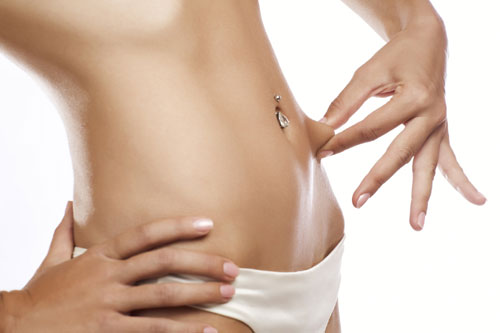Ultrasonic Assisted Liposuction
 As medical technology advances, better techniques and procedures become available for surgeons for the benefit of their patients. The fast growing advancing field of cosmetic surgery has enthusiastically welcomed and incorporated these advances and breakthroughs as soon as they become available and feasible.
As medical technology advances, better techniques and procedures become available for surgeons for the benefit of their patients. The fast growing advancing field of cosmetic surgery has enthusiastically welcomed and incorporated these advances and breakthroughs as soon as they become available and feasible.
In the constant effort to rid patients of unwanted fat, another method has been added to facilitate tried and tested techniques of liposuction, ultrasonic technology has been added to the growing plethora of a cosmetic surgeons tools, resulting in Ultrasonic Assisted Liposuction or UAL. The action of ultrasonic waves is the key to making liposuction quicker and easier.
How is Ultrasonic Assisted Fat Removal different?
Ultrasonic liposuction, or UAL, uses high-pitched sound waves to agitate, loosen and liquefy fat in a specific area to allowing mixing with an injected liquid medium, thus making it easier to remove as compared to the usual method of just poking and probing to physically loosen and remove fat deposits during traditional liposuction.
The Ultrasonic Liposuction Procedure
Ultrasonic liposuction is still liposuction, except it incorporates the use of ultrasonic devices either externally or internally and the ultrasonic sound waves are applied to the area to agitate and loosen fat cells and deposits into a liquid state.
Combined with an injected tumescent fluid, containing anaesthetic, saline solution, epinephrine, etc… the liquid fat emulsifies, making it easier and faster to remove.
Internal UAL
Internal UAL delivers ultrasonic energy directly to subcutaneous fat by a metal rod or cannula inserted through an incision in the skin. This technique enhances the current procedure in liposuction by adding ultrasonic waves to assist the breakdown and subsequent removal of fats in the immediate area being probed, shortening the necessary time the surgeon has to stay under the skin, and avoid possible mechanical damage to surrounding tissues.
External UAL
External ultrasonic assisted liposuction differs from internal ultrasonic assisted liposuction with regards to the source of the ultrasonic source, which in the case of external UAL is emitted from hand held devices positioned directly outside the body area concerned and the fats underneath are targeted and thus “pre-softened” and liquefied in preparation for subsequent liposuction.
Tools
The use of ultrasonics for cosmetic surgery has been around since the late 1980’s, and the equipment involved has improved from the older so called 1st and 2nd generation equipment to the more modern the 3rd generation, which are more efficient and less prone to causing “burns”.
In the case of Internal UAL, a metallic hollow probe called cannulae is inserted much like a regular liposuction cannulae, but it is connected to an ultrasonic generator that passes the ultrasonic vibration to the cannulae, which caused overheating with the 1st and 2nd generation equipments resulting in “burns”.
There are still surgeons who have not upgraded to the 3rd generation equipment due to higher costs, while some newer practitioners acquire the older but cheaper equipment.
Ultrasonic Liposuction Concerns & Risks
Detractors of the ultrasonic assisted liposuction claim that in comparison to ordinary non ultrasonic assisted liposuction, there is less risk of “burns”, which could cause adjacent tissue or nerve damage and that the newer generation of UAL uses bigger insulated cannulae to address the overheating may be prone to causing seroma, a condition which results in the formation of liquid bubbles left behind in the treated area and may cause unsightly bumps if not drained and may prevent proper tissue healing.
A unique risk is the possibility of blisters or burns. This can happen if the surgeon is inexperienced and lets the tip of the probe point up right under the skin.
Ultimately the cosmetic surgeons experience play’s a major role in the use of ultrasonics, by applying the proper techniques and use of suitable equipment
The ultrasonic waves have also raised concerns when used near the abdomen, chest and head areas due to the possible damage it can cause to internal organs situated in these regions.
Equipment breakage is also known to happen, older equipment is more prone to breakage due to the repeated uses, and the vibrations have weakened the cannulae and may cause eventual breakage. If the breakage occurs while the cannulae are still inside the patients body may require additional exploratory surgery to locate and remove the fragments.
Areas of the Body ideal for UAL Treatment
Ultrasound can help break up tough fats in areas of the body that are difficult to remove with traditional methods. Fats in the leg and arm areas for example are ideal for UAL because these areas are predominantly muscle and connective tissue that are used to movement and vibrations, so are not prone to the risks that ultrasound may have on nearby sensitive internal organs.
Final considerations…
Liposuction, both the traditional or ultrasound assisted method, helps you get rid of fats in your body, either method has it’s advantages and disadvantages. Talk to your surgeon and get his opinion on what would suit you better. Take your time, and get other opinions, don’t limit yourself, you could even consider having a combination of methods, using ultrasound assisted liposuction in certain areas only.
Ultrasound assisted liposuction (UAL) procedure could be right for you under certain circumstances, be prepared to shell out more money and spend more time finding and evaluating an experienced plastic surgeon with the right equipment. It’s your money and body after all.
